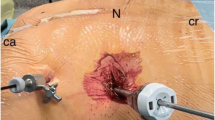Abstract
Purpose
Neurostimulation of the pudendal nerve (PN) is considered for patients who have failed sacral neuromodulation. Previous techniques for PN localization are described to be uncomplicated and promise to achieve accuracy in electrode placement. However, in clinical use, they appear challenging. We developed a puncture technique using fixed anatomical landmarks for a fast and reproducible localization of the PN.
Methods
Full-body cadavers and dissected anatomical preparations were studied for the course of the PN. Fluoroscopically controlled fixed anatomical landmarks locating the pudendal trunk were defined. Lead placement following established techniques was performed, and the topographic relationship to the PN was documented by dissection. In a pilot series of 20 patients with chronic pelvic pain, pudendal neuromodulation (PNM) was performed uni- and bilateral using the different approaches. Technical and clinical outcomes of the various techniques were compared.
Results
Fixed anatomical landmarks such as ischial spine, ischial tuberosity, acetabulum and anal rim resulted in a right-angled triangle with a new start and target point for puncture. Initials of the landmarks add up to the teaching acronym STAR. STAR technique including a puncture angle of 60° and a gluteal lead exit places 3–4 electrode poles at the nerve. In clinical trial, mean operation time for bilateral PNM in STAR was 85 min with mean puncture attempts of 3.5 to reach the nerve. Pain decreased statistically significant only in bilateral PNM.
Conclusions
The STAR approach appears to achieve technical standardisation and optimized reproducibility in pudendal lead placement resulting into an increased feasibility of PNM.



Similar content being viewed by others
References
Van Kerrebroeck PE, Marcelissen TA (2012) Sacral neuromodulation for lower urinary tract dysfunction. World J Urol 30(4):445–450. doi:10.1007/s00345-011-0780-2
Bosch JL (2010) An update on sacral neuromodulation: where do we stand with this in the management of lower urinary tract dysfunction in 2010? BJU Int 106(10):1432–1442. doi:10.1111/j.1464-410X.2010.09702.x
Schmidt RA (1989) Technique of pudendal nerve localization for block or stimulation. J Urol 142(6):1528–1531
Spinelli M, Malaguti S, Giardiello G, Lazzeri M, Tarantola J, Van Den Hombergh U (2005) A new minimally invasive procedure for pudendal nerve stimulation to treat neurogenic bladder: description of the method and preliminary data. Neurourol Urodyn 24(4):305–309. doi:10.1002/nau.20118
Peters KM, Feber KM, Bennett RC (2005) Sacral versus pudendal nerve stimulation for voiding dysfunction: a prospective, single-blinded, randomized, crossover trial. Neurourol Urodyn 24(7):643–647. doi:10.1002/nau.20174
Bock S, Folie P, Wolff K, Marti L, Engeler DS, Hetzer FH (2010) First experiences with pudendal nerve stimulation in fecal incontinence: a technical report. Tech Coloproctol 14(1):41–44. doi:10.1007/s10151-009-0554-7
van de Merwe JP, Nordling J, Bouchelouche P, Bouchelouche K, Cervigni M, Daha LK, Elneil S, Fall M, Hohlbrugger G, Irwin P, Mortensen S, van Ophoven A, Osborne JL, Peeker R, Richter B, Riedl C, Sairanen J, Tinzl M, Wyndaele JJ (2008) Diagnostic criteria, classification, and nomenclature for painful bladder syndrome/interstitial cystitis: an ESSIC proposal. Eur Urol 53(1):60–67. doi:10.1016/j.eururo.2007.09.019
Labat JJ, Riant T, Robert R, Amarenco G, Lefaucheur JP, Rigaud J (2008) Diagnostic criteria for pudendal neuralgia by pudendal nerve entrapment (Nantes criteria). Neurourol Urodyn 27(4):306–310. doi:10.1002/nau.20505
Peters KM, Killinger KA, Boguslawski BM, Boura JA (2010) Chronic pudendal neuromodulation: expanding available treatment options for refractory urologic symptoms. Neurourol Urodyn 29(7):1267–1271. doi:10.1002/nau.20823
Peters KM, Feber KM, Bennett RC (2007) A prospective, single-blind, randomized crossover trial of sacral vs pudendal nerve stimulation for interstitial cystitis. BJU Int 100(4):835–839
Scheepens WA, de Bie RA, Weil EH, van Kerrebroeck PE (2002) Unilateral versus bilateral sacral neuromodulation in patients with chronic voiding dysfunction. J Urol 168(5):2046–2050. doi:10.1097/01.ju.0000034352.91753.a5
Carmel M, Lebel M, Tule M (2010) Pudendal nerve neuromodulation with neurophysiology guidance: a potential treatment option for refractory chronic pelvi-perineal pain. Int Urogynecol J 21(5):613–616. doi:10.1007/s00192-009-1054-z
Kaufmann S, Naumann CM, Hamann MF, Seif C, Braun PM, Junemann KP, van der Horst C (2009) Unilateral vs bilateral sacral neuromodulation in pigs with formalin-induced detrusor hyperactivity. BJU Int 103(2):260–263
Laurberg S (2011) Sacral nerve stimulation for faecal incontinence: from voodoo to evidence-based medicine. Colorectal Dis 13(8):836. doi:10.1111/j.1463-1318.2011.02713.x
Acknowledgments
This study was awarded at the 22nd annual meeting of the Forum Urodynamicum 2011 in Mönchengladbach with the Eugen-Rehfisch-Prize.
Conflict of interest
The authors declare that they have no conflict of interest.
Ethical standard
The study protocol was approved by the ethics committee of the Ruhr-University of Bochum on March 2011 (registration number: 3919-11) prior to the study. Written informed consent was obtained from all participants.
Author information
Authors and Affiliations
Corresponding author
Rights and permissions
About this article
Cite this article
Heinze, K., Hoermann, R., Fritsch, H. et al. Comparative pilot study of implantation techniques for pudendal neuromodulation: technical and clinical outcome in first 20 patients with chronic pelvic pain. World J Urol 33, 289–294 (2015). https://doi.org/10.1007/s00345-014-1304-7
Received:
Accepted:
Published:
Issue Date:
DOI: https://doi.org/10.1007/s00345-014-1304-7




